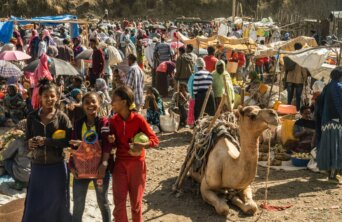- About
- Topics
- Story
- In-Depth
- Picks
- Opinion
- News
- Donate
- Signup for our newsletterOur Editors' Best Picks.Send
Read, Debate: Engage.
| topic: | Health and Sanitation |
|---|---|
| located: | Liberia, Ethiopia |
| editor: | Bob Koigi |
The world is currently facing a shortage of over 15 million health workers. This shortage is happening as the world battles old and new health crises such as COVID-19. As a result of health disparities, millions of people's lives are at risk.
In Africa, for example, over half of the population, approximately 615 million, cannot access the health services they need, with one doctor taking care of 3,000 patients, which is way below the World Health Organization's recommendations. Two out of every three mothers in Sub-Saharan Africa die during pregnancy. At the same time, one in two children living with HIV in East and Southern Africa has no access to antiretrovirals.
Consequently, Africa bears 26 per cent of the global disease burden and only has 3 per cent of the global health workforce. To turn the tide on the health crisis in the continent and ensure that Africa can meet its health needs top, among them universal health coverage and boosting pandemic preparedness, a new initiative has been introduced over the years.
The Community Health Workers model involves working with local health workers who are well known in the societies they serve and can provide primary healthcare instantly. They have been pivotal in bolstering the uptake of health services, reducing the health inequality gap, enhancing individuals' overall health and well-being, and offering jobs. One of the reasons the model has been successful, studies indicate, is because communities trust health workers who come from their region to give them accurate information and treatment. They are more open to discussing health matters with them.
Indeed, the value of community health workers cannot be overstated. For every $1 invested in them, up to $10 is gained in social and economic returns.
Alive to their role in enhancing better, integrated health care, governments, private institutions, and the international community have invested in the model.
For example, the One Million Community Health Workers campaign was introduced in 2013, bringing on board more than 150 organizations spanning UN agencies, academia, civil society, and the private sector to support African governments in enhancing healthcare by investing in lay health workers.
The Two Million Community Health Workers initiative was introduced afterwards to enhance the efforts of the One Million campaign, which has been training health workers on providing essential healthcare services, especially to the population that lives far away from health centres.
Liberia is one of the countries that has blazed the trail in entrenching community health workers in its health agenda. It has increased facility-based childbirth by more than 25 per cent. The West African country relies on these health workers to treat 45 per cent of all malaria cases for children under five years.
In Ethiopia, workers have effectively ensured timely contact tracing, risk communication, and medical supplies.
Yet despite the crucial role they play, these health workers are undervalued. Estimated to be about 916,000 in Sub-Saharan Africa, they are expected to serve more than 400 million people. Despite their efforts, up to 85 per cent of them have not received any salary or compensation.
The world must invest in locally-led interventions like community health workers to build resilient, equitable, and sustainable healthcare. There has to be a deliberate effort from governments to increase financing and show the political will to this crucial model that has proven over time that it has the potential to save lives. The private sector and other institutions should also support governments in ensuring that the model receives the focus and attention it deserves. Such an integrated healthcare initiative has the potential to ensure that we leave no one behind.
Image by Lesly Derksen.

